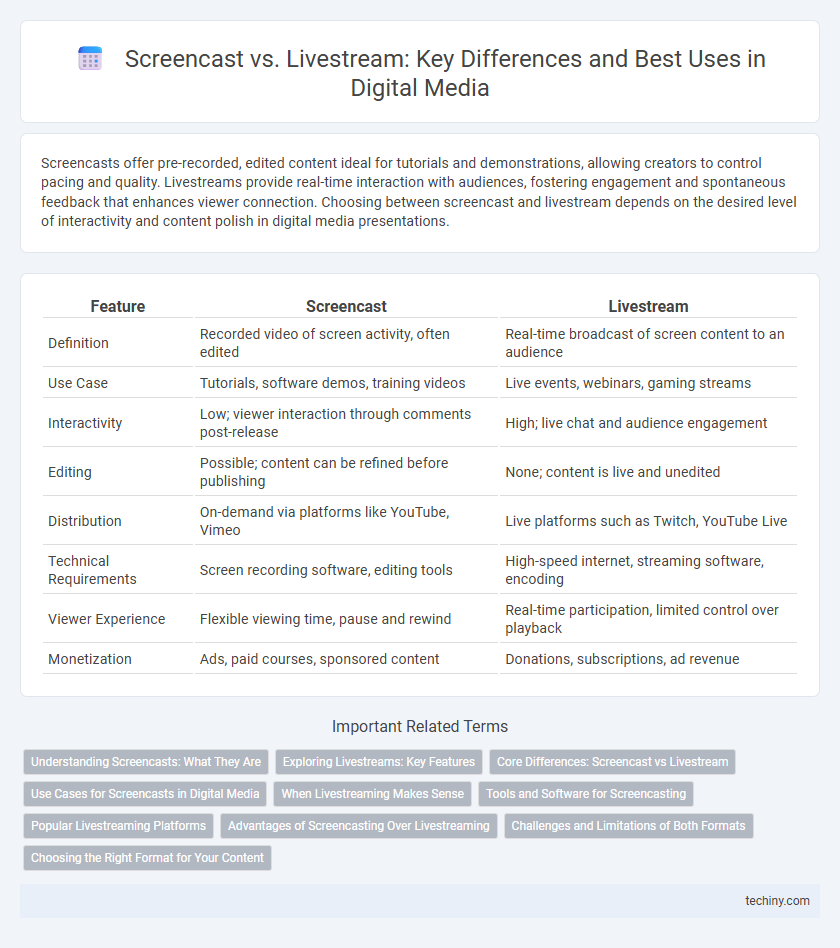Screencasts offer pre-recorded, edited content ideal for tutorials and demonstrations, allowing creators to control pacing and quality. Livestreams provide real-time interaction with audiences, fostering engagement and spontaneous feedback that enhances viewer connection. Choosing between screencast and livestream depends on the desired level of interactivity and content polish in digital media presentations.
Table of Comparison
| Feature | Screencast | Livestream |
|---|---|---|
| Definition | Recorded video of screen activity, often edited | Real-time broadcast of screen content to an audience |
| Use Case | Tutorials, software demos, training videos | Live events, webinars, gaming streams |
| Interactivity | Low; viewer interaction through comments post-release | High; live chat and audience engagement |
| Editing | Possible; content can be refined before publishing | None; content is live and unedited |
| Distribution | On-demand via platforms like YouTube, Vimeo | Live platforms such as Twitch, YouTube Live |
| Technical Requirements | Screen recording software, editing tools | High-speed internet, streaming software, encoding |
| Viewer Experience | Flexible viewing time, pause and rewind | Real-time participation, limited control over playback |
| Monetization | Ads, paid courses, sponsored content | Donations, subscriptions, ad revenue |
Understanding Screencasts: What They Are
Screencasts are digital recordings of a computer screen, often accompanied by audio narration, that capture software demonstrations, tutorials, or presentations. They serve as effective educational tools, enabling users to replay and learn at their own pace while preserving detailed visual and verbal instructions. Unlike livestreams, screencasts are pre-recorded content, allowing for precision editing and enhanced clarity before distribution.
Exploring Livestreams: Key Features
Livestreams offer real-time audience interaction through live chat, enhancing viewer engagement and community building. Their low latency streaming technology ensures minimal delay, making events like webinars, gaming sessions, and product launches highly dynamic and responsive. Advanced analytics tools track viewer behavior and engagement metrics, enabling content creators to optimize and tailor future broadcasts effectively.
Core Differences: Screencast vs Livestream
Screencasts capture pre-recorded video content of a computer screen, allowing for precise editing and focused messaging, while livestreams broadcast real-time events directly to viewers, fostering immediate interaction and engagement. Screencasts are ideal for tutorials, presentations, and training materials requiring clarity and repetition, whereas livestreams suit live events, gaming, and interactive sessions needing spontaneity. The core difference lies in the asynchronous nature of screencasts versus the synchronous, real-time communication of livestreams.
Use Cases for Screencasts in Digital Media
Screencasts are ideal for creating detailed tutorials, software demonstrations, and product walkthroughs in digital media, allowing users to pause and review content at their own pace. These recordings facilitate asynchronous learning and training, making complex information more accessible and easier to understand. Marketers and educators leverage screencasts to deliver step-by-step guidance, enhance user engagement, and reduce support inquiries.
When Livestreaming Makes Sense
Livestreaming makes sense when real-time interaction with the audience is essential, such as during product launches, webinars, or live events where immediate feedback enhances engagement. It leverages platforms like Twitch, YouTube Live, and Facebook Live to create a sense of urgency and community, fostering authentic connections. Brands benefit from livestreaming by driving spontaneous engagement, accelerating decision-making, and capturing moments that a pre-recorded screencast cannot replicate.
Tools and Software for Screencasting
Top screencasting tools like Camtasia, OBS Studio, and ScreenFlow offer powerful editing features, high-quality video capture, and customizable annotations tailored for creating polished digital media content. These software solutions support multi-source recording, flexible formats, and integration with popular platforms, enhancing workflow efficiency and viewer engagement. Unlike livestreaming platforms, screencast tools emphasize post-production capabilities, allowing creators to refine videos before publishing.
Popular Livestreaming Platforms
Popular livestreaming platforms such as Twitch, YouTube Live, and Facebook Gaming dominate the digital media landscape by providing real-time interaction and engagement for audiences worldwide. These platforms support high-quality video and chat features that foster community building and content creator monetization. Unlike screencasts, livestreaming enables instantaneous viewer feedback and dynamic content adaptation.
Advantages of Screencasting Over Livestreaming
Screencasting offers greater control over content quality through editing capabilities, allowing the removal of errors and enhancing clarity before publishing. Unlike livestreaming, screencasts provide asynchronous accessibility, enabling viewers to watch at their convenience without time constraints. This method reduces technical issues such as connectivity problems, ensuring a smooth and uninterrupted viewing experience.
Challenges and Limitations of Both Formats
Screencasts face challenges such as limited real-time interaction, making it difficult to address audience questions instantly, and potential technical issues with recording quality or software compatibility. Livestreams encounter limitations including dependency on stable internet connections, which can cause buffering or interruptions, and difficulties in managing viewer engagement due to live content unpredictability. Both formats require careful planning to balance production quality and audience experience while mitigating these inherent challenges.
Choosing the Right Format for Your Content
Selecting between screencast and livestream depends on your content goals and audience engagement. Screencasts offer polished, edited tutorials ideal for detailed demonstrations, while livestreams provide real-time interaction perfect for Q&A sessions and event coverage. Understanding your target audience's preferences and the complexity of your message ensures you choose the format that maximizes reach and impact.
Screencast vs Livestream Infographic

 techiny.com
techiny.com